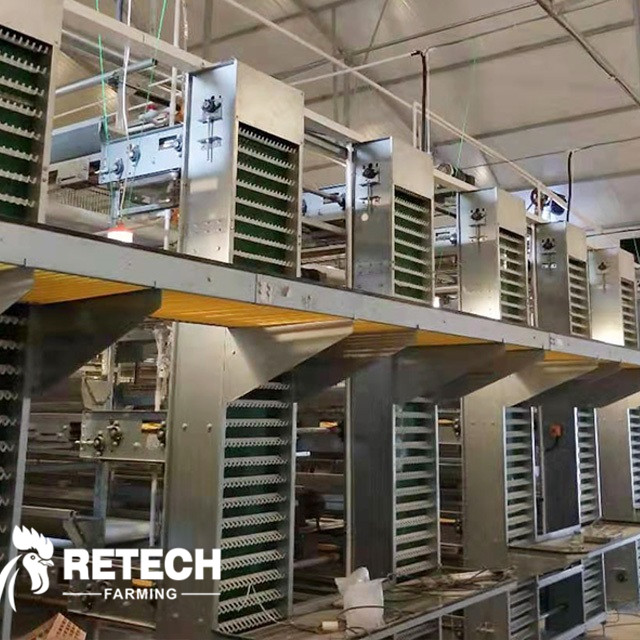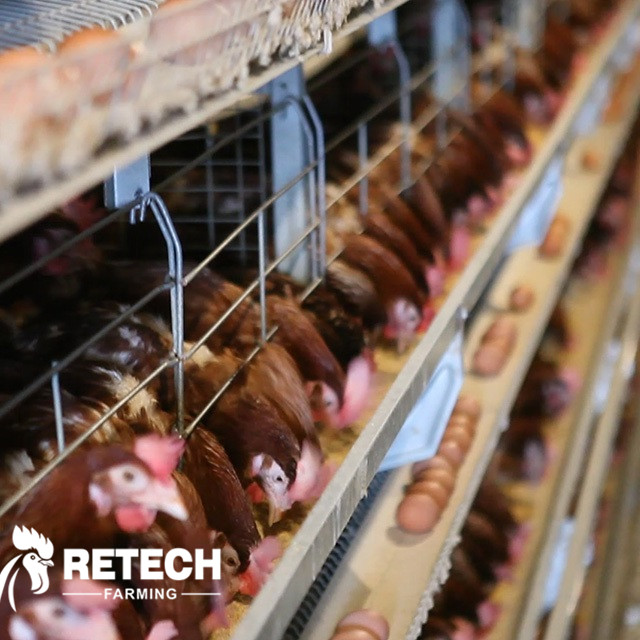1. Sesuaikan kawanan pada waktunya
Sebelum musim dingin, ayam yang sakit, lemah, cacat, dan tidak bertelur harus segera disingkirkan dari kawanan untuk mengurangi konsumsi pakan. Setelah menyalakan lampu di pagi hari di musim dingin, perhatikan kondisi mental, asupan makanan, air minum, feses, dll. dari ayam. Jika ayam ditemukan lesu, bulu rontok, feses berwarna hijau, putih, atau berdarah, mereka harus segera diisolasi dan diobati. Atau, setelah lampu dimatikan pada malam hari, dengarkan dengan saksama pernapasan ayam. Jika ditemukan batuk, mendengkur, bersin, dll., ayam yang sakit juga harus segera diisolasi atau disingkirkan untuk mencegah penyebaran infeksi.
2. Perhatikan untuk tetap hangat
Suhu yang cocok untuk ayam petelur adalah 16-24°C. Ketika suhu kandang lebih rendah dari 5°C, laju produksi telur akan menurun. Ketika suhu di bawah 0°C, laju produksi telur akan berkurang secara signifikan. Jika suhu terlalu rendah, konsumsi bahan akan meningkat secara signifikan. Pakan dan manajemenayam petelurDi musim dingin, pemanasan terutama bergantung pada kehangatan. Sebelum memasuki musim dingin, perbaiki pintu dan jendela, tutup terowongan angin, dan beri perhatian khusus untuk menutup lubang pembuangan kotoran guna mencegah terbentuknya area bersuhu rendah di area tersebut. Lapisan plastik pembungkus dapat ditutup di luar kandang ayam untuk mencegah masuknya pencuri. Jika perlu, pipa pemanas atau tungku pemanas dapat dipasang untuk meningkatkan suhu kandang ayam dengan tepat. Di musim dingin, suhu air minum ayam petelur tidak boleh terlalu rendah. Minum air bersuhu rendah dapat dengan mudah menyebabkan stres dingin dan merangsang mukosa gastrointestinal. Air hangat atau air sumur dalam yang baru dapat dipilih. Perhatikan penggunaan kain katun dan linen serta busa plastik untuk membungkus pipa air guna mencegah pipa air membeku dan retak.
3. Meningkatkan ventilasi
Di musim dingin, kontradiksi utamanya adalah insulasi dan ventilasi kandang ayam. Ventilasi yang berlebihan tidak kondusif untuk insulasi kandang.peternakan ayamVentilasi yang buruk akan meningkatkan konsentrasi gas beracun dan berbahaya seperti amonia, karbon dioksida, dan hidrogen sulfida di kandang ayam, yang akan menyebabkan penyakit pernapasan dan memengaruhi laju produksi telur. , kualitas cangkang dan berat telur. Oleh karena itu, perlu dilakukan ventilasi yang teratur dan tepat. Ventilasi dapat dilakukan ketika suhu tinggi di siang hari. Jumlah dan durasi kipas atau jendela dapat dibuka sesuai dengan kepadatan kawanan, suhu di dalam kandang, kondisi cuaca, dan tingkat stimulasi gas beracun dan berbahaya. Diputuskan bahwa ventilasi intermiten dapat digunakan selama 15 menit setiap 2 hingga 3 jam, sehingga gas berbahaya di kandang ayam dapat dibuang sebanyak mungkin, dan udara di kandang ayam dapat dijaga tetap segar. Selain itu, saat ventilasi, jangan biarkan udara dingin berhembus langsung ke tubuh ayam, tetapi juga mencegah perampokan. Pada saat yang sama, perlu untuk membersihkan kotoran ternak tepat waktu untuk menghindari pembentukan gas berbahaya.
4.Kontrol kelembaban yang wajar
Kelembapan lingkungan yang sesuai untuk ayam petelur adalah 50-70% dan tidak boleh melebihi 75%. Kelembapan yang berlebihan di kandang ayam tidak hanya akan meningkatkan pembuangan panas, memengaruhi efek insulasi kandang ayam, tetapi juga menciptakan kondisi untuk reproduksi bakteri dan parasit. Pemeliharaan sistem air minum secara teratur diperlukan untuk menghindari pipa air, pancuran air minum atau tangki air bocor dan membasahi tubuh ayam dan pakan, sehingga dapat menghindari peningkatan kelembapan di dalam kandang dan pembuangan panas tubuh ayam. Jika kelembapan kandang ayam terlalu rendah, mudah menyebabkan penyakit pernapasan pada ayam. Umumnya, udara kering di musim dingin, dan kelembapan dapat ditingkatkan dengan menyemprotkan air hangat atau air disinfektan di koridor.kandang ayam.
5.Waktu cahaya tambahan
Ayam petelurAyam petelur membutuhkan cahaya hingga 16 jam per hari, dan cahaya memiliki efek merangsang produksi telur. Di musim dingin, siang hari pendek dan malam hari panjang, dan cahaya buatan diperlukan untuk memenuhi kebutuhan cahaya ayam petelur. Anda dapat memilih untuk menyalakan lampu di pagi hari sebelum fajar, mematikan lampu setelah fajar, menyalakan lampu di sore hari ketika tidak ada sinar matahari, dan mematikan lampu di malam hari untuk memastikan 16 jam cahaya. Tetapi untuk memastikan keteraturan, yaitu menyalakan dan mematikan lampu secara teratur, bola lampu dapat dilengkapi sesuai dengan 2~3W/m2, tinggi bola lampu sekitar 2 meter di atas tanah, dan lampu pijar biasanya digunakan.
6.Pembersihan dan disinfeksi secara teratur
Cuaca dingin di musim dingin membuat daya tahan ayam umumnya lemah, yang dapat dengan mudah menyebabkan wabah penyakit pernapasan. Oleh karena itu, disinfeksi secara teratur diperlukan. Disinfektan dapat dipilih dari obat-obatan dengan iritasi yang lemah dan kurang toksik dan efek samping, seperti Xinjierzide, asam perasetat, natrium hipoklorit, Untuk keracunan, dll., beberapa disinfektan dapat digunakan dalam rotasi silang untuk menghindari resistensi obat. Waktu disinfeksi paling baik dilakukan di malam hari atau di bawah cahaya redup. Saat mensterilkan, perlu untuk menutupi semua aspek, sehingga obat jatuh secara merata di permukaan kandang ayam dan tubuh ayam dalam bentuk kabut. Saluran masuk udara dan bagian belakang kandang ayam harus disterilkan. Dalam keadaan normal, disinfeksi harus dilakukan seminggu sekali.
7.memastikan nutrisi yang cukup
Di musim dingin, ayam petelur perlu mengonsumsi lebih banyak energi untuk mempertahankan suhu tubuh, dan sebagian energi ini berasal dari pakan. Oleh karena itu, perlu meningkatkan proporsi minyak pakan berenergi, jagung, beras pecah, dll. dalam formula pakan, serta meningkatkan kandungan vitamin dan mineral secara tepat untuk memenuhi kebutuhan ayam petelur di musim dingin. Selain itu, frekuensi pemberian pakan dapat ditingkatkan untuk meningkatkan kualitas pakan ayam petelur.
Waktu posting: 25-Mar-2022










